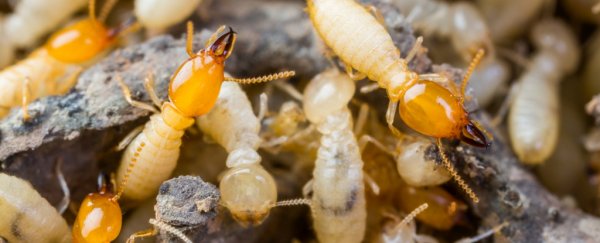For the first time, scientists have discovered all-female termite colonies, living and flourishing in Japan. While we know of several insect species that easily thrive without any males, this is an exciting new development in our understanding of asexual reproduction.
Most species on this planet reproduce sexually, requiring both male and female gametes in order to produce offspring.
Every now and again, though, a species is able to reproduce asexually. This is called parthenogenesis, and it's been observed in animals such as sharks, lizards, snakes, amphibians and fish.
It also shows up in the insect world. Aphids are one famous example; phasmids such as stick and leaf insects are another.
Meanwhile, bees and ants not only sometimes reproduce asexually, they also live in all-female colonies, producing males solely for mating with the queen before unceremoniously booting them out.
But termites are a completely different order from Hymenopteran ants and wasps - they're Blattodea, making this new discovery all the more exciting.
While termites also have a queen that produces the majority, if not all, of the colony's offspring, they also have her counterpart - a king - who fathers the offspring. Colonies also typically consist of an equal mix of asexual male and female workers, which work together for the good of the colony.
But when studying colonies of the species Glyptotermes nakajimai in Japan, researchers were surprised to discover that some seemed to have not a single male among the insects they counted.
Over the course of a year and a half, they studied 74 colonies from 15 field sites across the country, painstakingly counting individuals, and found 60 percent of the colonies were male-less.
Next they went looking at reproduction. When a termite queen successfully mates, she reserves some of the king's sperm in a special storage organ. In the all-female colonies, the queens' sperm pouches were empty. They were laying unfertilised eggs - which were hatching at the same rate as fertilised eggs in the mixed colonies.
"These results demonstrate males are not essential for the maintenance of animal societies in which they previously played an active social role," said evolutionary biologist Nathan Lo of the University of Sydney.
Every now and again, the mixed colonies produced unfertilised eggs, which suggests that the all-female parthenogenetic colonies evolved from the mixed ones. And the all-female colonies were isolated to the small southern islands of Shikoku and Kyushu.
After digging into their genetic material, the team found the schism between the two types of colonies happened around 14 million years ago.
The researchers believe that switching to parthenogenesis may give the bugs an advantage when establishing colonies in a new environment.
"All else being equal, asexual populations grow at twice the rate of sexual populations because only females are required to reproduce," Lo said.
"This increased growth rate of colonies makes it easier for populations to entrench themselves in new environments."
Because the populations have been separated for so long, it's possible that the newer all-female colonies may eventuate in a new species, which would mean we're observing evolution in action.
According to the team, the termites are already showing morphological and population differences; the insects heads in the all-female colonies are more evenly sized, and the all-female colonies have fewer soldiers.
For now, though, while they're still technically the same species, the discovery is indicative that the dynamics of advanced animal societies can change significantly.
"Our findings demonstrate that completely asexual social lineages can evolve from mixed-sex termite societies, providing evidence that males are dispensable for the maintenance of advanced animal societies in which they previously played an active social role," the researchers wrote in their paper.
The research has been published in the journal BMC Biology.
